VGA to workstation monitor FAQ
Copyright 1997,1998,1999,2000 Tomi Engdahl
Making the connection to VGA card
Connecting VGA card to various monitors
- VGA to 5 BNC connectors
- VGA to 4 BNC connectors
- VGA to 3 BNC connectors
- VGA to 13W3 connector
- VGA to Apple
- VGA to coin-up monitor connector
- VGA to mono monitor
- VGA to LCD monitor
- VGA to HDTV display
- VGA to coin-up videogame monitor
- VGA to CGA monitor
- VGA monitor to monitor with TTL level RGB inputs
- VGA to monitors with ECL inputs
Questions and answers
What tools are needed to do the connection ?
In simplest case you don't need any tools. If you have a suitable ready made cable for connecting your monitor to your VGA card then you don't need any electronics tools. You have to know the software tools which are used to configure your display card settings to be able to configure right monitor type to it's drivers.
If there is no ready made cable for doing the connection then you need to do the cable and maybe some electronics yourself. For making your own cable you need at least a small screwdriver, low power soldering iron made for electronics work, solder and wire cutters. If you need to make connections to BNC connectors you will need a special tool for this. When making your cable you must have the basic knowledge how to build electronics. If you don't have those skills ask help from a friend who knows how to build this kind of things.Things are not very hard but little experince helps much. A multimeter is very useful for checking that the cable is connected as it should and you don't have any short circuits in it.
If you need to build some electronics then you also need the components for the circuit and preferably some circuit board for the components (if there is more than few of them). For most of the project a simple veroboard is enough. For testing the circuit a multimeter is absolutely necessary because if anythign goes wrong it is very hard to find what's wrong without it. In some harder to find problem cases an oscilloscope is a very useful tool to check that everything works as it should.
For those who connect to fixed frequency monitors that need vary caferul adjustments of the sync signals to show any picture, I recommend to get you hands to and oscilloscope and/or frequency counter to see what's really going out of the video card (and if it matches the specs). Sometimes the output from the video card is not what you would expect from the settings file. If you can't see what's really coming out of the video card is is very hard to find where the problem really is.
What kind of cable should I use in the connections ?
The connection of the R, G, B and sync signal shoudl be made using 75 ohm coaxial cable. If you happen to use any other type of cable you will quite propably see a radical drop in picture quality (loss of details, shadowing etc.). A cheap computer grade cable might work on 640x480 resolutions, but will not definatly work well on 1024x768 at 75 Hz refresh rate.
How do I connect a monitor with 5 BNC connections to VGA card ?
The monitors which have 5 BNC connector inputs are easy cases because the signals they need are similar to the ones VGA card gives. The only difference that those monitors use 5 high quality BNC connectors instead of cheap 15 pin VGA connector.
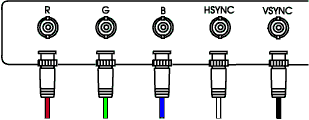
There are ready made cables available because they are used with some high end PC displays and some workstations. If you want to make your own cable then look at the following diagram which is based on recommended cable diagram published in one Nokia monitor manual. The original circuit digram in the manual had some mistakes, but I have corrected all mistakes form the picture I have found.
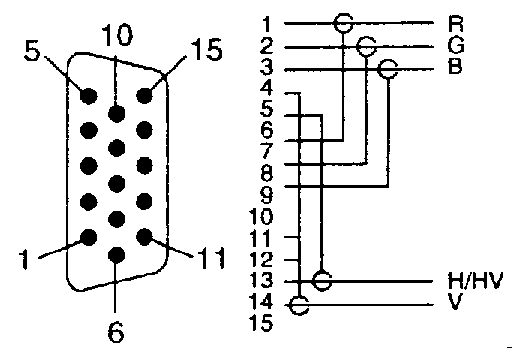
This kind of monitor cables are available ready made on good computer ships, so you don't necessarily have to make one yourself (unless you want to). The grounding arrangements can vary slightly from cable to cable, the signal connections are the same in commercial cables.
Other wiring method suggested in "Notes on Video Conversion" by Samuel M. Goldwasser:
Coax Center Coax Shield
---------------------------------------
Red Video (1) Red Return (6)
Green Video (2) Green Return (7)
Blue Video (3) Blue Return (8)
H Sync (13) Ground (5,10)
V Sync (14) Ground (5,10)
You can use either of those wiring schemes, both should work well and perform in the same way.
Here are some tips how to make the connection correctly:
- Use 75 ohm BNC connectors for terminating the cable on monitor end.
- Use 75 ohm coaxial cable for all connections. If you happen to put anything else to those connections you will regret that because the impedance mismatch will destroy the picture quality on high resolutions. If you can find 75 ohm mini-coaxial cable, that is best for short runs and easiest so solder.
When plugging in the cable make sure that the Red, Green, Blue, Horizontal Sync (HSYNC, usually white or gray wire), and Vertical Sync (VSYNC, usually black wire) connections are firmly in place and plugged into the correct input.
Set each of your monitor's RGB input (if available) to 75 ohms. Set sync set to "external" and sync level to TTL (if there is such setting). These controls are usually switches on the back of your monitor.
If you don't get picture and you he the frequencies set right, try to exchange the HSYNC and VSYNC cables, especially if you connected them by the wire colors and not by the markings on the cable. The cable color coding in HSYNC and VSYNC is not universal standard, which means that different manufacturers can use different colors for HSYNC and VSYNC wires. And I have even seen cables where there has been mistake that the connectors for HSYNC and VSYNC were named wrong on the ready made cable!
What is the polarity of the sync signals ?
Sync signals applied to monitor BNC connectors are traditionally negative polarity. PC VGA card uses different sync polarities for telling the monitor about which resolution is in use, so the sync signal polarity changes from mode to mode. If you don't have specs of your monitor then negative polarity in both HSYNC and VSYNC is the best configuration to start experimenting.
If you get the sync polarities wrong then the the monitor might not display any picture or it does not sync to the video signal. Other possible problems might be that you see only part of the picture. Some monitors work with many sync signal polarities, but might have different monitor settings for every sync signal polarity combination (this applies to some older PC multisync monitors).
How do I detemine what kind of sync my monitor needs ?
For monitors with BNC connectors, it may be possible to determine capabilities by counting them:
- 3 BNCs - Sync-on-green only (Red, Green+Sync, Blue)
- 4 BNCs - Composite sync (R,G,B,CS) and possibly sync-on-green
- 5 BNCs - Separate syncs (R,G,B,HS,VS) and possibly composite or sync-on-green as well
What about sync polarity ?
Sync polarity (whether the pulses are negative or positive going) may be an issue depending on the design of the monitor. Some monitors need sync at exactly certain polarity and some monitors ca accept both polarities. Some monitors (like original IBM VGA monitor) use different sync polarities in different screen modes to be able to use the right screen settings for that monitor (the electronics has adjustments for different screen modes). Most PC video cards can be programmed for either polarity.
How do I connect a monitor with 4 BNC connectors to VGA card ?
The monitors which use 4 BNC connectors have connectors for Red, Green, Blue and composite sync signals.
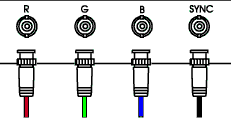
Because VGA card does not supply composite sync signal then the separate sync signals (HSYNC and VSYNC) must be combined using (usually either OR or XOR) some electronics to make a composite sync signal. The picture below shows the idea of the VGA to 4 BNC connector cable with sync combinining electronics in it.
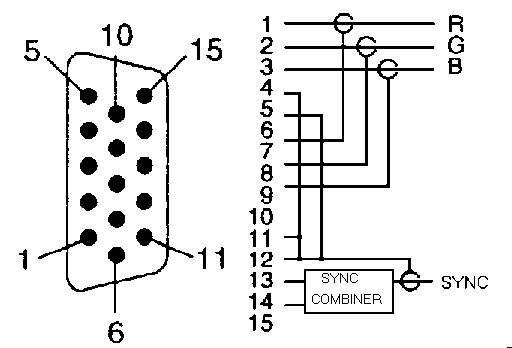
The basic idea for the combining circuit is the following:
HSYNC--------|-------\
| GATE |------CSYNC OUT
VSYNC--------|-------/
The gate type should be selected using following table:
AND: for -ve logic sync and no hsync during vsync
NOR: for +ve logic sync and no hsync during vsync
XOR-NOT: for -ve or +ve logic sync and hysnc during vsync
This circuit takes TTL level syncs from PC VGA card
and outputs TTL level composite sync output. If you have
some equipment which asks for lower level (1V or so) sync
signal to 75 ohm input then add a 470 ohm resistor in series
with the gate output to reduce the sync signal level to that.
One example circuit based on XOR-NOR gate (XOR forllowed with NOT) can be found at http://cvs.anu.edu.au/monitorconversion/Csync.gif.
I have designed on circuit to do sync combining suync signals of any polarity combination. The description of those circuit is available at http://www.hut.fi/Misc/Electronics/circuits/vga2rgbs.html. If you need to build am external 5V power supply for that circuit then take a look at the circuit diagram http://www.hut.fi/Misc/Electronics/circuits/psu_5v.html.
Many companies which make accessories for video and data projectors have ready made interfaces for connecting VGA to monitor or video projector which has 4 BNC inputs (those adapters typically cost $200 or more).
Some video cards (like the ATI GUP, GPT, and others) can be programmed in their SETUP or INSTALL program (or possibly from a command line option) to generate composite sync on the H or V sync wire. These will then work (at least with respect to sync) with a monitor requiring either separate or composite syncs. A few high-end cards can generate sync-on-green as well. For connecting this kind of video card to your monitor get a ready made VGA to 5 BNC cable (you just won't use one of the sync connectors).
How do I connect a monitor with 3 BNC connectors to VGA card ?
The monitors which use only 3 BNC connectors have only connectors for Red, Green and Blue signals.
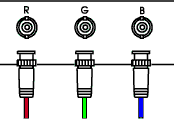
The sync information in those monitors are typically fed through the same connector which carries the Green picture component. This arrangement is called "sync on green". The sync could be as well in any other picture component signal, but I have never seen other than green picture component used for sync signal.
Some PC graphcis cards support this function so you might check if you card and drivers support this option. If the hardware does not support sync on green then you need to build some electronics to convert normal VGA signals to sync on green RGB signal The picture below shows the idea of the VGA to 3 BNC connector cable with sync combinining electronics in it.
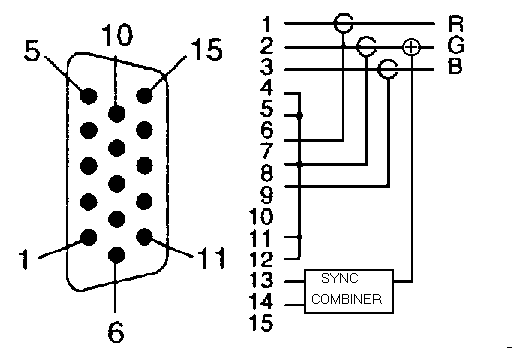
The basic idea of the circuit is that it consists of sync combining circuit which combines the HSYNC and VSYNC signals to one composite sync signal. After the combining, the signal is just summed (at right level) to the green picture signal with suitable electronics.
Many companies which make accessories for video and data projectors have ready made interfaces for connecting VGA to monitor or video projector which needs sync on green RGB signal (those adapters typically cost $200 or more).
There is one conversion circuit described at http://nyquist.ee.ualberta.ca/~charro/cookbook/video/vga2rgb.asc. If you need to build am external 5V power supply for that circuit then take a look at the circuit diagram http://www.hut.fi/Misc/Electronics/circuits/psu_5v.html.
One recommended circuit on many web pages to
circuit to convert PCVGA to RGB is the following circuit which includes both
sync combining (the gate) and the signal summing circuit (rest of
the circuit):
+5.0V
|
/
\ VR1 (1k carbon mini pot)
/
33uF tantalum | ~0.3V DC in porch area
GREEN------|----||-----|--------------------|-----GREEN to monitor
|----||-----| |
.1-.01uF ceramic |
|
_|
HSYNC--------|-------\ |
| GATE |------CSYNC---------|| VN10KM or similar small
VSYNC--------|-------/ |_ N channel enhancement MOSFET
|
Gnd
HSYNC, VSYNC and CSYNC are grounded with 4.7k carbon resisitors.
The gate type should be selected using following table:
OR: for -ve logic sync and no hsync during vsync NAND: for +ve logic sync and no hsync during vsync XOR: for -ve or +ve logic sync and hysnc during vsyncCapacitors are optional if the VGA card can nicely take that small amount of current that this circuit pushes to the video line. VR1 should be adjusted so that the porch levels to 0.3V and 0 level (sync level) to 0.0V. Warning: Do not adjust VR1 to to near to 0 ohms, this can cause damage to the VGA card, MOSFET and the trimmer itself. This design might not be the prettiest or most convient way to do the conversion, but in many web pages anyway it is reported to do what it is designed to do quite well.
How do I connect SUN monitor with 13W3 connector to VGA card ?
SUN monitors use 13W3 connector which looks like 25 pin D-connector where some of the pins are replaced with tiny coaxial connectors.
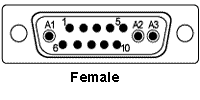
Here is the most common pinout used:
Analog: 13W3 connector:
+----------------- * gnd
| +------------- * vertical sync
| | +--------- sense 2
| | | +----- sense common (gnd)
| | | | +- composite sync
| | | | |
| | | | | grey
red | | | | | green blue
| 1o 2o 3o 4o 5o | |
(O) (O) (O)
6o 7o 8o 9o 10o
| | | | |
| | | | +--- composite common (gnd)
| | | +------- sense 0
| | +----------- sense 1
| +--------------- * gnd
+------------------- * horizontal sync
* May be not connected.
The picture signals go in those coaxial connector parts (red, green and blue)
and the sync signal goes through composite sync pin in SUN monitors.
Only the green video input is used by grayscale monitors.
There are also many other signals in the same connector but those are not typically needed for anything when you connect the monitor to PC. The descrption of the connector can be found from comp.sys.sun.hardware FAQ which is available at ftp://ftp.cs.unc.edu/pub/users/mueller/sun.faq. The same 13W3 connector is also used by Silicon Graphics in their workstations.
There is a picture of 13W3 interface and the necessary electronics at http://cvs.anu.edu.au/monitorconversion/Csync.gif. That picture is a part of Use your old Workstation Monitors with Linux/XFree86 document. Timing details of Sun monitors can be found at http://www.inforamp.net/~poynton/notes/short_subjects/comp.graphics/Sun_1152x900_timing.
How do I connect an Apple monitor to PC VGA card ?
Original Apple Macintosh monitors were typically fixed frequency monitors which are only designed to display one resoluon at on refresh rate. Here are some specificationd of some Apple computers and their monitors:
- Mac II - analog (35 KHz H, 66.67 Hz V - 640x480) 15 pin.
- Mac II and Quadra - analog (49.7 KHz H, 74.55 Hz V - 832x624) 15 pin.
resolution: 832x624 pixel clock rate: 57.2832 MHz vertical scan rate: 75 Hz horizontal scan rate: 49.7 kHzThe original Apple monitors were fixed frequency only monitors, but some monitor manufacturers have built their monitors for Apple using multisync monitor electronics. So some monitors are indeed multisync monitors. It depends on which monitor you happen to have. Some Mac monitors are multisync, those that are could be used on a PC, however most older ones are fixed frequency. Virtually all of the models made after 1995 or so are multisync, and will work just fine on a PC with the special Apple monitor to SVGA adapter (if the Apple monitor comes with the Mac style DB15), or newer ones just come with the PC style HD DB15.
You can try the following cable pinouts to make that VGA connector
to apple 15 pin video connector adapter:
Mac Video DB15 VGA Connector HD15
---------------- --------------------
2 ------------------- Red Video ------------ 1
1 ------------------- Red Ground ----------- 6
9 ------------------- Blue Video ----------- 3
13 ------------------- Blue Ground ---------- 8
5 ------------------- Green Video ---------- 2
6 ------------------- Green Ground --------- 7
15 ------------------- Hsync ---------------- 13
12 ------------------- Vsync ---------------- 14
14 ------------------- Sync Ground ---------- 10
If the monitor you are using is multisync model and you have the PC screen mode in range it can handle you should get the picture with this circuit. If you don't get picture, then the monitor might be fixed frequency and you have to tweak you PC screen refresh rate and resolution to match that that monitor wants.
One thing: color calibration is intended to be handled by a Mac desktop bus or USB serial connection to the monitor. If you use a PC, you don't have this calibration capability and if you attempt to adjust the color temperature of the monitor with the manual controls, you get a horrid default setting that can't be changed unless you hook a suitable Mac back up and recalibrate.
More information can be found at http://www.repairfaq.org/REPAIR/F_vidconv.html#VIDCONV_075.
My monitor has a strange connector which I don't now. How can I use it ?
There are so many different proprietary video interfaces used in computer monitors that it is outside scope of this FAQ to cover all of them. If you need to interface some strange monitor connector to VGA card then you should read Notes on Video Conversion document which is available at http://www.repairfaq.org/REPAIR/F_vidconv.html. Also document Identifying connections on unknown or cut monitor cables is useful in some cases to help finding what pin in the connetor does which.
The picture below shows a generic wiring to be used with monitors which have separate sync inputs and one common ground for all signals:
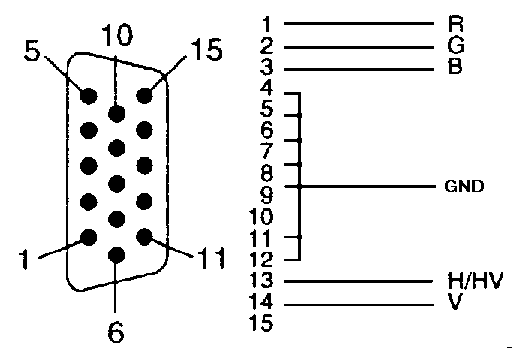
What to do monitors with about 15-16 kHz horizonal sync rate and 50-60 Hz horizonal rate ?
The monitors which use 15625 Hz or 15750 Hz horizonal sync rate are very similar to normal television are designed for viewing normal interlaced TV standard video at 50 or 60 Hz field rate. If you have this kind of monitor it might not be very useful as computer text display because you will need to use interlacing to get any usable resolutions (640x480 or 800x600). If you want to use theis monitor with your PC vga card then you first have to make the suitable connection between VGA card and the monitor. When you have made the connection you caa try to test the drivers made for VGA to TV converter circuit described at http://www.hut.fi/Misc/Electronics/circuits/vga2tv/index.html. Take also look at http://mameworld.retrogames.com/pc2jamma/phard5.html.
How do I wire my VGA card to an LCD module ?
Nowadays there are many different color LCD screen available. There are very many LCD modules and even complete LCD monitors with VGA connectors.
Interfacing those LCD screens is not different compared to interfacing other monitors. First you have to find out an LCD module with analogue RGB inputs. Then you have to figure out the sync format it wants. If the monitor has separate sync inputs, then VGA signals as they are. If it needs composite sync, then you need to build some interfacing electronics. And when you have made the hardware interfacing, you must make you computer to output correct picture format to the screen (right resolution and scan rates).
The LCD module application note is a necessary information source when you are interfacing those LCD modules to your PC. From there you get to know the pinout and what kind of signals they use. Generally those modules accpet TTL level sync signals and standard 0.7Vpp video signal but do not provide internal 75 ohm termination for RGB signals (you have to provide external remination resisotr for this, ideally 75 ohms, but usually any valus from 68 to 82 ohms will work). You can find one LCD module interfacing project example at http://home1.gte.net/bs/sharp2.html.
Generally most of the inexpensive small LCD screen can't go up to even the standard 640x480 VGA resolution. There are screens with resolutions from 240x240 to 640x480. Some of those screens take VGA signal directly and some work on normal TV rates. You have to look at the datasheest of the display you plan to use to determine what is the correct format for your particular display.
Can VGA card connected to HDTV receiver ?
I have not personally tried any HVTV receiver interfacing, because the HDTV standard has not catched the markets in Europe as it is in USA (still beginning there also). I try to collect here some technical data on HDTV system in used in USA so that people who are interrested in experimenting on interfacing to their HDTV receivers have some grounds to start with their own experimenting.
You may have heard that there are 18 different HDTV transmission formats. That is not true. There are only six that offer any image resolution above our beloved NTSC system (525 lines, 480 visible, interlaced scan). Those are:
- 1,920 pixels on 1,080 lines, progressively scanned at 30 Hz refresh
- 1,920 pixels on 1,080 lines, interlaced scan at 30 Hz refresh
- 1,920 pixels on 1,080 lines, progressively scanned at 24 Hz refresh
- 1,280 pixels on 720 lines, progressively scanned at 60 Hz refresh
- 1,280 pixels on 720 lines, interlaced scan at 30 Hz refresh
- 1,280 pixels on 720 lines, progressively scanned at 24 Hz refresh
This means that HDTVs in use in USA can handle 480 lines progressive scan, 720 lines progressive scan or 1080 lines interlaced scan picture. That 1280x720 lines progressive scan 10 Hz refresh mode seems to be th emost promising mode for computer display use.
Current HDTV ready receivers in USA some receivers have typically YUV inputs (some have also possibility for RGB) with around 15-20 MHz bandwidth for HDTV picture. Theorerically HDTV receivers with RGB input could be connected to a PC with suitable cable and right screen mode settings on PC and a suitable cable (I have not verified this bevcause I have't come acrossa any such TV yet).
The ones with YUV inputs can't be directly interfaced that easily (to connect them you will need to build some RGB-YUV conversion electronics which is not included in this document). Besides the picture component format there is difference in sync formats. standard UYV (Y, Pb and Pr) interface in HDTV system uses different sync system than traditional video signals. Analogue HDTV format uses tri-level sync, which is different from normal video sync (bi-level sync). First Tri-level sync exists on each of the video signal channels (Y, Pb and Pr). The format of Tri-level sync is such that sync starts at 0 VDC, then goes through a negative-going period, followed by a positive-going period, then back to 0 VDC. The negative and positive sync pulses are a nominal - or + 300 mV in amplitude from DC. Each of the pulses are defined to be 44 samples in width and the sync signal rise time is defined to be 4 samples. Tri-level sync has a defined broad pulse structure for defining the vertical interval. Since tri-level sync, and other timing parameters of the HD signal, are specified by specific sample points within the interval, the actual sync time is format specific. SMPTE 274M is one of the more inclusive standards relative to HDTV signal format.
Here is some technical data of HDTV system in used in USA:
| DTV
Format |
Scan
Lines |
Horizontal
Pixels |
Aspect
Ratio |
Picture Rate
I= Interlaced P=Progressive |
| HDTV | 1080 | 1920 | 16:9 | 60I, 30P, 24P |
| HDTV | 720 | 1280 | 16:9 | 60P, 30P, 24P |
| SDTV | 480 | 704 | 16:9 | 60P, 60I, 30P, 24P |
| SDTV | 480 | 704 | 4:3 | 60P, 60I, 30P, 24P |
| SDTV | 480 | 640 | 4:3 | 60P, 60I, 30P, 24P |
Propably the most suitable modes for computer display would be 720 line progressive scan mode (1280x720 resolution):
ATSC 720P
- Horizonal rate: 45000 Hz
- Field rate: 60 fields/seconds
- Picture format: 720 visible lines progressive (750 total)
- Horizonal resolution: 1280 active pixels (1650 total)
- Pixel clock: 74.25 MHz
- Vertical retrace: 667 microseconds
- Horizonal retrace: 4.98 microseconds
- Sync format: Special 3-level sync signal
Other potentially useful mode is the highest resolution 1080 line interlaced mode. Although the reolution is better, the interlacing can be a potential problem.
ATSC 1080I
- Horizonal rate: 33750 Hz
- Field rate: 60 fields/s
- Picture format: 1080 lines interlaced (1125 total) or 540 lines non-interlaced
- Horizonal resolution: 1920 active pixels (2200 total)
- Pixel clock: 74.25 MHz
- Vertical retrace: 667 microseconds
- Horizonal retrace: 3.77 microseconds
- Sync format: Special 3-level sync signal
What about coin-up videogame monitors ?
Understanding Monitor Specs
There are few different monitor types used in coin-up games. The single most important value when you look at any monitor's specs is the horizontal scanrate. This value will tell you almost everything you need to know about the monitor's capabilities. The scanrate will probably be one of the following on coin-up monitors:
Resolution Scanrate Low/Standard 15.7 kHz Medium 25 kHz High 31.5 kHzThe vertical scan rate used is typically around 60 Hz.
There are many different connectors used in coin-up game monitors. Propably the most frequently used and best stadardized connector is JAMMA connector, which is described at http://www.mameworld.net/pc2jamma/images/jamma.gif.
Standard resolution monitors
The most typical specification of the monitors used in the coin-up games is and RGB monitor with about the same specifications as normal TV. Standard resolution monitors have a horizontal scanning frequency of 15,750 Hz. Actually, this figure is 15,734 Hz in an NTSC standard system.) Vertical frequency is 60 Hz (59.92 to be exact.) This used to be that was all that we needed and all that was available. Now, there are higher resolution systems that require different monitors.
Drivers made for VGA to TV converter circuit described at http://www.hut.fi/Misc/Electronics/circuits/vga2tv/index.html will do the job to adapt the scan frequencies suitable for those monitors.
There might be some hardware interfacing problems with this kind of monitors, because there are different interfaced used in his type of monitors. Some monitors might take analogue RGB signals from VGA directly (0.7Vpp to 75 ohm load), but there are also other implementations. For analogue connections there is also used analogue negative RGB signal with around 5Vpp signal level (Black level around 5-5.6V and Saturated Color level at around 0.9V). With this kind of monitors the direct RGB signal conversion does not work and infortuantely I don't have any interfacign electronics available for this. And then there are also some monitors with TTL level digital RGB inputs (and I don't have circuit for them either).
Medium resolution monitors
The next step up in resolution is a medium resolution standard. In computer lingo, this is EGA resolution. The medium resolution standard uses a horizontal scan frequency of 25 kHz and a vertical scan rate of 60 Hz. This is the standard first used in games like Paperboy, APB, Super Sprint, Championship Sprint, Hard Drivin, Race Drivin and Steel Talons.
VGA resolution
VGA resolution has a horizontal frequency of 31.5 kHz and vertical frequency of 60 Hz. This is equivalent of 640X480 lines of resolution in a desktop computer system.
Video input
All conventional videogames use monitors with RGB inputs. Amny monitors use normal analogue RGB signals, but there are also monitors which use TTL level RGBI signals. If the monitor has standard analogue RGB inputs then you can just wire the RGB inputs directly to VGA card RGB signals (for example popular "Antarex" monitors should be this type). Those monitors with RGBi signal inputs can't be easily interfaced to VGA acard, so they are quite useless in PC applications. Some coin-ups use digital RGBI signals for picture and those can't be easily converted for VGA display. There are also some special monitors which use some special RGB signal levels not compatible with the ones used in normal VGA screen. It is bets to first check the specs of your monitor before starting the project.
In some cases, there is a separate connection for both the vertical and horizontal sync. Most of the time, the vertical and horizontal sync signals are combined to a composite sync signal.
The vertical and horizontal sync signals may be positive sync or negative sync. Both sync systems are equally effective. The designer of the games hardware simply chooses one system or the other. In order to make their monitors compatible with any computer system, most monitor manufacturers have designed their monitors to accept both positive and negative sync inputs. Some monitors use a switch to select either positive or negative sync, others are designed to accept either sync polarity at a single connector; automatically detecting its polarity.
Virtually all game systems of today use composite negative polarity sync.
If the monitor uses separate HSYNC and VSYNC signals then try to wire the VGA sync signals diretly to them. If the sync polarities are not correct you can adjust them to suit to the monitor (by configuring the drivers or selecting suitable driver) or adapt the polaritioes using some simple electronics (NOT gates). If the monitor wants composite sync signal you can make a TTL level composite sync signal using the circuit described at http://www.hut.fi/Misc/Electronics/circuits/vga2rgbs.html.
You can find information on interfacing PC various monitors on game cabinets also at PC2JAMMA project pages.
What to do with monitors that have TTL level inputs ?
This type of monitors do not have much use with modern PC graphics cards. TTL level monitors have very limited number of colors and limited gray scale. TTL level interface uses different signal levels in picture signals than PC VGA card (TTL signal is 0V or 5V and analogue VGA RGB uses 0.7Vvv signal levels). The sync signals in TTL monitors have the same levels than PC VGA card which also uses TTL level sync signals.
TTL level monitors typically only have two available intnsisties in each color component: on and off. Typically the monitors have also an extran intesity bit, which will (when activated) turn all color components which are on to the intensified state (more output level). The interface which has RGB and intensity bits is usually called to have RGBI interface. RGBI interface supports 16 colors. RGBI monitors are used many older computer systems (for example PC CGA card). Some TTL level monitors (IBM EGA monitor etc.) have two bit input and support typically three levels: black, white and intensified white.
Technically it is possible to convert the analogue RGB signals to the TTL level signals with some electronics. For example if you amplify the analogue RGB signals to 5Vpp signal level range, you get RGB signal which TTL level RGB inputs can take. Another option is to use a fast signal comparator which compares if the analogue video RGB signals are over some predeterminex threshold level and then turn the correspondign bits on the monitor input on. This kind of conversion is usually nor feasible, because you need quite much electronics (fasto comparators and some logic gates) to do the conversion and the performance of such TTL level RGBI monitors do not meet your expectations of a PC monitor (colors limited 16 fixed colors, poor resolution, poor refresh rate etc.).
Can I use monocrome monitors with my VGA card ?
You can use monocrome monitors with the VGA card if the interface specs and the refresh rate match what your VGA card can output. There original VGA card supported a monocrome VGA monitor si that the monitor take all it's picure information from GREEN wire and the sync signals as the mormal VGA monitor. When the VGA card knew that there was a monocrome monitor connected to it, it programmed the palette to be a grayscale palette. So monocrome VGA monitor saw all the picture material in grayscale format.
Nowadays the monocrome monitors are practically not used in modern PC systems, so the support for those does not work todays as well as it used to be (VGA card might not support the moncrome monitor detection well ot the software overrides the monocrome settings). The most foolproof way to do the conversion is to make an external circuit which combines RGB signals to one monocrome video signal. The signals can be combined with set of resistors as in the circuit below:
VGA CONNECTOR
____
RED 1 >-+-----------|____|----+
| ____ 82 ohm |
+-|____|-+ |
180 ohm | |
BGND 6 -----------+ |
____ |
GREEN 2 >-------------|____|----+----------------> VIDEO OUT
22 ohm |
____ |
BLUE 3 >-+-----------|____|----+
| ____ 240 ohm
+-|____|-+
100 ohm |
BGND 8 -----------+
GGND 7 ------------------------------------------ VIDEO GROUND
HSYNC 13 >----------------------------------------> HSYNC
VSYNC 14 >----------------------------------------> VSYNC
GND 5 ----------------------------------------- GROUND
This circuit can be used with mono VGA monitors. It can be also
used with other monocrome moitors which take separate sync signals
and 0.7Vpp video signal input.
If the monitor uses monocrome composite video signal, then you can try the circuit below to convert the RGB and sync signals from the VGA card to composite video signal.
VGA CONNECTOR
____
RED 1 >-+-----------|____|----+
| ____ 82 ohm |
+-|____|-+ |
180 ohm | |
BGND 6 -----------+ |
____ |
GREEN 2 >-------------|____|----+-------------> VIDEO OUT
22 ohm |
____ |
BLUE 3 >-+-----------|____|----+
| ____ 240 ohm |
+-|____|-+ |
100 ohm | |
BGND 8 -----------+ |
|
BC548 ___ |
HSYNC 13 >------ __---|___|-+
\ /| 680 ohm
\ /
---------
____ |
VSYNC 14 >--|____|--+
1 kohm
GND 5 --------------------------------------- VIDEO GND
Note: This circuit takes all the operation power it need from
the VGA card signals (mostly the sync signals). In oder the
circuit to operate both HSYNC must be active low (negative sync)
and VSYNC must be active low (negative sync). If the sync
polarities are somethign else, the circuit does not produce proper
output signal.
Here is another VGA monocrome composite video signals.
This circuit is taken from Notes on Video Conversion document. This circuit expects
that the VGA card is in monocrome VGA mode when it is in use
R1
Hsync o--------/\/\/------------+
|
R2 |
Vsync o--------/\/\/------------+
|
R3 |
Green Video o----+---/\/\/--+---------+--------o Composite Video In
| ^ | (Termination = Hi Z)
\ +----+
/ +--------o GND of monitor
\ R4 |
/ |
| |
GND (shield) o----+--------------------+
Construction details:
- Connect Hsync through 500-1K ohm (R1) to Composite Video In.
- Connect Vsync through 500-1K ohm (R2) to Composite Video In.
- Connect Green Video through 200 ohm (R3 - variable) to Composite Video In.
- Connect Green Video side of R3 to Ground through an 82 ohm (R4) line termination resistor.
- Tie green and sync grounds to the BNC or RCA connector ground.
- Build this circuit as close to the monitor as possiblefor best signal quality.
- Set monitor video termination for Hi-Z.
- Set your video card for negative sync polarity.
- You may need to tweak these values for best results. This will depend on your actual signals. The variable R3 may provide enough range for this.
Those monocrome conversion circuits do not solve all monocrome monitor conversions, because there are many different monocrome monitors in use in workstations. Some workstations have used only black and white monitors (only white and black values) with TTL or ECL level video signals.
VGA to CGA monitor
CGA monitors have horizontal scanning frequency of 15,750 Hz and screen refresh rate of 60 Hz. CGA monitors use TTL level separate sync signals. The picture signal itself is transported to VGA monitor using digital TTL-level (0-5V) RGBI (red,green,blue,intensity) interfache which can represent 8 colors with 2 intensity values for each. CGA monitors are designed to supportpicture resolutions up top 640x200 pixels. CGA monitors use 9 pin D-connector with following pinout:
1 Ground 2 Ground 3 Red 4 Green 5 Blue 6 Intensity 7 (not in use) 8 Horizonal Sync [+] 9 Vertical Sync [+]
Because VGA card typically use HSYNC rate of more than 30 kHz and CGA monitor wants exactly 15.750 kHz, there is need to use some special drivers or conversion programs to make the VGA card to match this picture rate. Changing the settings on the VGA card is the only realitic way to do the conversion, because it would be difficult and not safe to modify the CGA monitor for such a substantial change in horizontal scan rate. Therefore, I would not recommend even making the attempt to do such changes.
If you happen to have an operating system where you can quie freely change the sync rates and screen resolutions (for example Linux) then you can make your VGA card to send picture at the rate that CGA monitor wants with the right sync signal polarities (both HSYNC and VSYNC positive). If you do not get the frequencies right, the picture on monitor will look quite much as a complete mess or quite similar as watching a scrambled cable TV channel without the cable TV decoder.
The other problem that exists is that the analogue RGB signals sent by the VGA monitor are not directly usable by CGA monitor. If the CGA monitor expects strictly a TTL input, you will not get any signal with VGA signal input. If the CGA monitor is not that strict, then you might get some if the brighest parts of you VGA picture somehow show on CGA screen. The simplest idea for the proper level conversion would be to have some special amplifier circuit which amplifies the analogue 0-0.7V signal levels to TTL level (0..3-5V) as accpeted by CGA card. You could use some kind of video amplifier circuit or fast voltage comparators with reference signa level set to around 0.3-0.4V. That kind of circuit would give you 8 colors on CGA monitor screen. If some extra electronics is added, up to 16 colors are in theory possible. I have no ready circuit design for such conversion.
NOTE: There has been some general purpose monitors sold for also CGA use which had also analogue RGB signal inputs. If you happen to have such monitor, you can do the connection of RGB signals directly without any conversion electronics in between and get full set of VGA colors on that old monitor (the pinout for R,G,B and sync pis is same as for normal CGA connector). Still in this case you will need to get the sync frequenciesthat VGA card outputs right to make the picture to show right.
VGA monitor to monitor with TTL level RGB inputs
Analogue RGB signals sent by the VGA monitor are not directly usable by TTL level input. If you connect VGA analogue RGB to TTL level RGB input, you will not get any sisible picture because the signal level on analogue RGB input is much lower than TTL input epects to show anything at all.
A TTL level RGB inputs use signal lavels so that anything lower than aound 1V is considered to be no black and anything more than 2.5V is considered to be that picture component full on. There are only two states for each RGB component, either full on or full of. VGA card analogue RGB output ooutput signals almost any value in the range of 0-0.7V depering on the picture brighness. The signal level even on the brightest VGA picture component value (0.7V) is so low that if it is conneted to TTL level input, that input considers it to be always black.
Even if you could amplify the signal levels from VGA signals to something a TTL level input can take, then there are still problems to be solved until you get any usable picture from VGA. One problem is that TTL level RGB monitors have only very limited number of colors, which means that the colors you get on that kind of monitor with any adapter circuit is very crude approximation of what it looks on VGA screen. A pure only RGB TTL inputs can only show total number of 8 colors. A more oten used TTL level RGBI can show 16 colors (8 colors with two intensity levels for each).
Other thing on monitors with TTL level inputs is those monitors do not support normal VGA scan rates. Typically something quite similar to CGA monitors (15750 Hz HSYC and 60 Hz refresh rate).
VGA to monitors with ECL inputs
Some workstation monitors (for example Moniterm Viking) use ECL level monitor interface instead of normal analogue monitor interface. ECL level video signals are 2 level signals in the range of -5V to 0V. The ECL signals are usually transferred in complementary format (video signal has separate plus and minus signals, usually called differential ECL format). The ECL input acts as an comparator. The result is on or off depending on which signal has higher potential. Usually both plus- and minus-video have their on ground wires.
VGA video signal level (0 to 0.7 V) is directly incompatible with the ECL interface descibed above in both signal polarity and signal levels. This causes that you jsut can't wire the VGA output pins to the monitor and expect it to work.
The most straigtforward way to do the conversion would be to take firs a fast comparator with around 0.3V reference voltage level, connect in to VGA video signal wire and the connect the output of theat comparator to the differential ECL output driver chip output. This is basically working idea, but easily gets quite complicated.
Fortunately there are few simpler tricks which can be sometimes used to adapt VGA signals to ECL inputs. The DC levels of the VGA signal can be tricked with few tricks to the negative voltage range using quite few components. And as ECL input is a comparator we can fool it to accept a lower than normal level video signal by setting the other comparator input to right voltage level thear the voltages the DC component converted VGA signal has.
A document available at http://www.hut.fi/~pelle/vga-ecl.txt has an example circuit for this conversion.
Tomi Engdahl <[email protected]>









